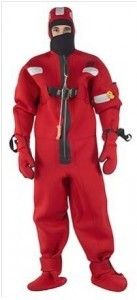SOLAS REQUIREMENT FOR IMMERSION SUIT
- An immersion suit, complying with the requirements of the Code, of an appropriate size, shall be provided for every person assigned to crew the rescue boat or assigned to the marine evacuation system party.
- An immersion suit of an appropriate size complying with the requirements of the Code shall be provided for every person on board the ship. However, for ships other than bulk carriers, these immersion suits need not be required if the ship is engaged in warm climates where, in the opinion of the administration, immersion suits are unnecessary.
- If a ship has any watch or workstations which are located remotely from the place where immersion suits are normally stowed, including remotely located survival craft carried in accordance with the regulation of the code, additional immersion suits of an appropriate size shall be provided at these locations for the number of persons normally on watch or working at those locations at any time.
- Immersion suits shall be so placed as to be readily accessible and their position shall be plainly indicated.
- The immersion suits required by this regulation may be used to comply with the requirement mentioned above.

ADDITIONAL REQUIREMENTS FOR IMMERSION SUIT
The immersion suit shall be constructed with waterproof materials such that:
- It can be unpacked and donned without assistance within 2 min, taking into account any associated clothing, and a lifejacket if the immersion suit is to be worn in conjunction with a lifejacket;
- It will not sustain burning or continue melting after being totally enveloped in a fire for a period of 2 seconds;
- It will cover the whole body with the exception of the face. Hands shall also be covered unless permanently attached gloves are provided;
- It is provided with arrangements to minimise or reduce free air in the legs of the suit;
- Following a jump from a height of not less than 4.5 m into the water, there is no undue ingress of water into the suit. An immersion suit which also complies with the requirements of life-jackets may be classified as a life-jacket. An immersion suit which has buoyancy and is designed to be worn without a lifejacket shall be fitted with a light and the whistle complying with the requirements for lifejackets. If the immersion suit is to be worn in conjunction with a lifejacket, the lifejacket shall be worn over the immersion suit. A person wearing such an immersion suit shall be able to don a lifejacket without assistance.
In that case, immersion suit shall permit the person wearing it
- To climb up and down a vertical ladder at least 5 m in length;
- To perform normal duties associated with abandonment;
- To jump from a height of not less than 4.5 m into the water without damaging or dislodging the immersion suit, or being injured;
- To swim a short distance through the water and board a survival craft.
An immersion suit made of a material which has no inherent insulation shall be
- Marked with instructions that it must be worn in conjunction with warm clothing;
- So constructed that, when worn in conjunction with warm clothing, and with a lifejacket if the immersion suit is to be worn with a lifejacket, the immersion suit continues to provide sufficient thermal protection, following one jump by the wearer into the water from a height of 4.5 m, to ensure that when it is worn for a period of 1h in calm circulating water at a temperature of 5°C, the wearer’s body core temperature does not fall more than 2°C.
- An immersion suit made of material with inherent insulation, when worn either on its own or with a lifejacket, if the immersion suit is to be worn in conjunction with a lifejacket, shall provide the wearer with sufficient thermal insulation, following one jump into the water from a height of 4.5 m, to ensure that the wearer’s body core temperature does not fall more than 2°C after a period of 6h immersion in calm circulating water at a temperature of between 0°C and 2°C. A person in fresh water wearing either an immersion suit or an immersion suit with a lifejacket shall be able to turn from a face-down to a face-up position in not more than 5 seconds

Leave a Reply